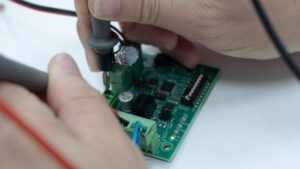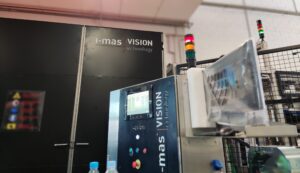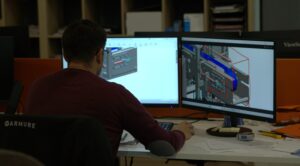Robotics has undergone a dramatic advancement in the last 20 years. From highly specialized industrial robots to autonomous systems that interact with humans, the evolution of this discipline has been driven by advances in artificial intelligence, sensors and materials.
In this article, we will explore the evolution of robotics from 2005 to the present day, highlighting its main milestones and trends, and also celebrate 20 years of i-mas, a company that since 2005 has been leading innovation in engineering and product design, contributing with innovative solutions in industrial automation, machine vision and deep learning.
The consolidation of industrial robotics and the rise of mobile robots (2005-2010)
In 2005, robotics was dominated by industrial applications, with companies such as KUKA, FANUC and ABB leading the way in factory automation. Robots were mainly mechanical arms programmed to perform repetitive tasks with high precision. However, around the same time, advances in mobile robotics and human interaction began to emerge.
One of the most important milestones was the introduction of the iRobot Roomba, a cleaning robot that popularized the concept of home service robotics. Progress was also made in autonomous robots for logistics, with the first prototypes of mobile robots in automated warehouses.
In the field of humanoid robotics, Honda significantly improved its ASIMO robot, giving it greater autonomy and responsiveness to external stimuli. In parallel, universities and research centers began to develop robots with more sophisticated artificial intelligence.
Artificial intelligence drives robotics (2010-2015)
At this stage, artificial intelligence and machine learning began to play a key role in the evolution of robotics. The introduction of more advanced sensors, such as 3D cameras and LiDAR, enabled robots to perceive their environment more accurately.
One of the most relevant events was the emergence of collaborative robots or cobots, designed to work alongside humans without the need for safety barriers. Brands such as Universal Robots revolutionized the industry with robotic arms that are easy to program and more accessible to small and medium-sized companies.
Another breakthrough was the development of autonomous vehicles, with Google (now Waymo) leading research into driverless cars. In parallel, Amazon began testing its robots in warehouses to improve the efficiency of its logistics.
In the field of humanoid robotics, Boston Dynamics presented improved versions of Atlas and BigDog, robots with impressive mobility that demonstrated a breakthrough in locomotion and balance.
The explosion of robotics in new sectors (2015-2020).
During this period, robotics ceased to be limited to industrial environments and began to impact sectors such as medicine, agriculture and services.
One of the most relevant milestones was the proliferation of surgical robots, with the Da Vinci system allowing increasingly precise and less invasive interventions. In agriculture, harvesting robots and drones began to be used to improve efficiency and reduce costs.
Another significant development was the consolidation of autonomous delivery robots, with companies such as Starship Technologies and Nuro developing last-mile solutions for package and food distribution.
The rise of artificial intelligence also allowed conversational robots, such as Hanson Robotics’ Sophia, to show amazing human interaction capabilities, albeit still with limitations in their understanding of context.
The era of advanced automation and autonomy (2020-2025)
In recent years, robotics has evolved towards systems that are more autonomous, flexible and adaptable to different environments. The combination of artificial intelligence, advanced sensors and cloud computing has enabled the development of more efficient robots with greater learning capabilities.
One of the biggest recent advances has been the implementation of robots in healthcare, with mobile units capable of assisting patients, disinfecting spaces and supporting hospital logistics. The COVID-19 pandemic accelerated the adoption of these systems in hospitals and healthcare centers.
In industry, intelligent automation has given way to more flexible and adaptable factories, with robots able to reprogram themselves and work on multiple tasks. Autonomous robotics has also been key in sectors such as space exploration, with the success of Perseverance, NASA’s robot exploring Mars from 2021.
In addition, humanoid robots have advanced significantly, with Elon Musk introducing in 2022 the Tesla Optimus prototype, a robot designed to perform repetitive and assistive tasks in various industries.
The future of robotics is shaping up to become more autonomous and collaborative with humans. Advances in artificial intelligence, machine vision and deep learning will allow robots to become increasingly intuitive and able to adapt to changing environments. In the coming years, we are likely to see increased adoption of personal robots, autonomous home assistants, and robotic systems that are more integrated into society.



